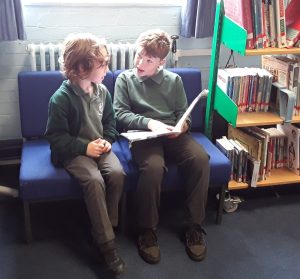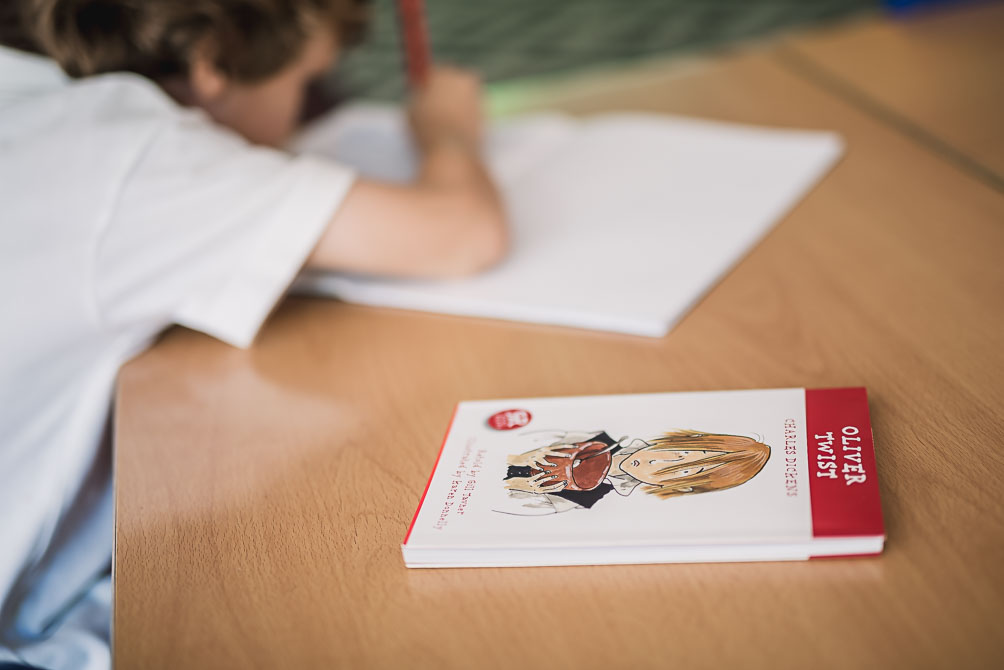Reading and Phonics

Reading and Phonics
At St. Mary’s CofE Primary School, we aim to foster a love of reading and are aware of the importance it plays in children’s cultural, emotional, intellectual, social and spiritual development. Children are encouraged to discover the value of strong communication and the importance of Reading and Writing in all aspects of their futures.
‘So it is with children who learn to read fluently and well: They begin to take flight into whole new worlds as effortlessly as young birds take to the sky’
William James
Reading Policy
Our reading policy outlines our approach towards reading in some detail. You can access this policy clicking on this link: Reading Policy
Reading Intent:
We aspire for our children to:
- Develop an enthusiasm for reading and an enjoyment of books, which leads to a desire to want to read for both pleasure and for information.
- Develop the skills and competencies necessary to decode words, read fluently, understand and respond to a variety of texts (both fiction and non-fiction).
- Develop the skills of reading necessary for information gathering and for the purpose of study.
- Develop reading in all subjects to support their acquisition of knowledge.
- Read widely at school and at home.
- Leave St. Mary’s with a life-long love for reading.
Reading Implementation
Our English curriculum is based around carefully chosen, high quality fiction and non-fiction texts (please refer to our Curriculum Maps and Literacy Frameworks). They represent a wide range of genres, time periods and cultures and cover a variety of topics. For example, Year 4 study ‘Gregory Cool’, by Caroline Binch, which is about family relationships set in Tobago; Year 5 study ‘Journey to Jo’burg’, by Beverley Naidoo, set in South Africa during apartheid. Children’s writing, as a product of their immersion in texts, is proudly displayed around the school.
We demonstrate to children that reading enables us to acquire knowledge and to build on what we already know. Staff also model reading for enjoyment, through discussing what they love to read and why. This is reflected in the school environment, with staff sharing their most loved books.
Across the school, children are encouraged to challenge and discuss their ideas with each other, building on their ability to communicate their thoughts clearly and justify their opinions.
Reading is taught through daily reading opportunities, such as whole-class shared reading, phonics sessions and reciprocal reading discussions/activities. Skills of decoding, fluency, inference and deduction are taught, which children can apply to any genre of text.
Approach Towards Developing Early Reading Skills and Phonics
Throughout Reception year and Key Stage One, the sharing of high quality texts is at the heart of our Literacy curriculum.
In November 2021 we began following Essential Letters and Sounds which is a DFE validated systematic synthetic phonics programme. Phonics teaching begins within the first few weeks of children starting Reception. The ELS programme focuses on developing phonological awareness, phoneme-grapheme recognition and the strategies of blending to read and segmenting to spell. This document provides an overview of progression within the ELS phonics programme:
ELS is delivered through daily discrete phonics lessons. During these sessions teaching assistants are carefully deployed so as to ensure that all children are being appropriately challenged and supported.
Regular assessment ensures that we are quick to identify children who need additional support. The English Learning Leader and SENCO work closely with class teams to ensure that these interventions are implemented in a highly effective manner.
When children are engaging in reading and writing activities across the curriculum, teachers encourage them to use knowledge and skills from discrete phonics sessions. This is promoted through explicit modelling, drawing children’s attention to phonics resources such as friezes and by regularly reminding children about their expectations.
Fluency
“Fluent reading supports comprehension because pupils’ cognitive resources are freed from focusing on word recognition and can be redirected towards comprehending text.” Education Endowment Foundation
As children become more confident with decoding text, we support them in developing their fluency, by considering how they read with speed, accuracy, expression and intonation.
One of the key techniques we use to support children with their fluency is echo reading, which involves pupils ‘echoing’ the adult’s ‘read aloud’, one sentence at a time, trying their best to mimic fluency, expression and intonation. There is discussion around why the adult used certain expression, volume or intonation. Reference to use of punctuation marks is also made.
Comprehension Skills
Throughout their reading journey, we seek to develop children’s comprehension skills through reciprocal reading. This involves scaffolded discussions that incorporate four main strategies (the ‘Fab Four’) that readers use together to comprehend text:
- Predicting
Predicting goes beyond guessing and involves previewing the text to anticipate what may happen next. Readers can use information from the text along with their prior knowledge to make logical predictions before and during reading. This encourages a purpose for reading and allows more interaction with the text, resulting in more interest and understanding. Phrases such as, ‘I wonder if…’ and ‘I think…will happen because…’ are modelled and encouraged.
- Questioning
Questioning is an important strategy for good readers. Children are encouraged to ask questions before, during and after reading. Teachers model how to ask questions based on inferences and main points in the text. Children learn to generate questions about a text’s main idea, important details and textual inferences, which helps to improve their reading comprehension skills. Question starters might include, ‘Why…?’, ‘What if…?’, ‘How do you think…?’
- Clarifying
Clarifying is a complex strategy that helps children monitor their own comprehension as they identify problems they are having in understanding portions of text or figuring out the meaning of difficult words. Adults model how to effectively use clarifying strategies, such as reading on to look for clues; rereading the parts they didn’t understand; thinking about what they already know; thinking of another word that looks similar. This helps pupils to become more strategic readers.
- Summarising
Teaching children to summarise text is a research-based, effective way to improve overall comprehension (Duke & Pearson, 2002; EEF 2017). Reciprocal reading provides children with opportunities to experience others’ summarising and to create their own summaries, which helps them to become more proficient readers. These prompts may be used to guide children with their summaries: ‘The most important ideas in this text are…’; ‘The story takes place…’; ‘The main characters are…’; ‘A problem occurs when…’; ‘In the (beginning, middle, end),…’
Reciprocal Reading Prompts for Parents/Carers
Reading For Pleasure
Stories are often shared at our school and staff and children often share with each other ‘recommended reads’. We celebrate World Book Day every year and enjoy browsing and buying books at our annual book fair. Click to view our World Book Day Virtual Library that we set up during Lockdown in March 2021, which features recordings of members of staff sharing their favourite texts!
During the Lockdown in January 2021, we provided opportunities for children to access reading books from school and we also launched our own St Mary’s Virtual Library to enable children to enjoy books while libraries were closed and school was not open to all children.



Our Y6 children also help to promote a love for reading by sharing stories with their Reception buddies in our library:


In Reception and KS1, we use the Oxford Reading Tree reading scheme. We use Accelerated Reader in Years 2 – 6, which is a computerised program that helps teachers to assess their pupils’ reading comprehension and helps pupils to select books based on their reading level. The children really enjoy completing a quiz once they have finished their book.
All KS2 classes have an annual Shakespeare text focus in the Autumn term. The children have an opportunity to participate in a theatre workshop at school which supports their comprehension and vocabulary development of Shakespearean language before they begin their unit of work.



By the time the children leave St. Mary’s, they will have studied 4 Shakespearean texts, participated in 4 workshops led by the Young Shakespeare Company and seen 4 live theatre productions of the plays at the Wyllyotts Theatre in Potters Bar.
The children have a number of immersive experiences to help develop their love for words and stories:

Y1 enjoying tea with The Tiger Who Came to Tea.

KS2 re-enacting scenes from Lewis Carroll’s The Jabberwocky

KS1 exploring the story of the Owl and Pussy Cat by Edward Lear
For information about the reading knowledge and skills taught within each year group, please see these documents:
Reading Progression Y1-Y6
KS2 READING Executive Summary
Reading Results:
2022 KS2 Reading Results: 86% of children achieved the expected standard or above. 48% achieved a ‘high score’ (110 or above) above the expected standard.
By the end of 2018/19, pupils in KS1 attained in the top 15% and pupils in KS2 in the top 11% when compared to all schools nationally for the expected standard in Reading.




